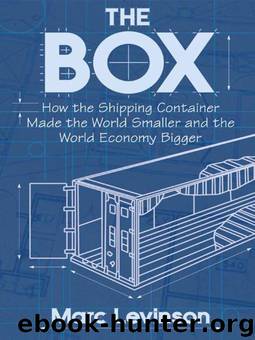The Box by Marc Levinson

Author:Marc Levinson
Language: eng
Format: mobi, epub
Tags: Non-fiction
ISBN: 9780691136400
Publisher: Princeton University Press
Published: 2008-01-02T00:00:00+00:00
Chapter 10
Ports in a Storm
The Coastwise Steamship Company had been created to serve the paper industry. Since the 1930s, its ships had picked up rolls of newsprint from Crown Zellerbach’s mills at Port Angeles and Camas, in Washington State, and hauled them down the coast to California. The business was reliable—until the Southern Pacific and Union Pacific railroads went after the traffic. They exempted newsprint from their general rate increases in the 1950s, and then they began to lower their rates in order to capture the cargo. To compete, the ship line had to slash its tariff for news-print from $32 to $18 per ton. By 1958, Coastwise Steamship Company was near insolvency, and the Pacific coastal trade in newsprint was dead.1
As with newsprint, so with cotton and oranges, chemicals and lumber. American coastal shipping withered during the 1950s in the face of a competitive onslaught by trains and especially trucks. The number of cargo ships engaged in coastwise trade, aside from tankers, fell from 66 in 1950 to 35 in 1960, and the total tonnage of active coastal ships dropped by one-third. The waterfronts that had once been vital to local economies fell into decay as the ships stopped coming. Docks were abandoned, warehouses bricked up. Over the thirteen years from 1945 to 1957, total investment on construction and modernization at all North American ports outside New York came to a meager $40 million a year.2
Two events tied to containerization brusquely awakened the somnolent port industry. In December 1955 came the Port of New York Authority’s decision to turn 450 acres of New Jersey salt marsh into a futuristic port for containerships, a scheme utterly beyond the capability of any other port in the world. Less publicized, but even more ominous, were the changes in Malcom McLean’s container service. McLean had gone to great trouble to secure rights to serve ports from Boston to Galveston, and the fully containerized ships Pan-Atlantic introduced in 1957 were given expensive onboard cranes so they could call at almost any port. The plan was for Pan-Atlantic’s vessels, like traditional ships, to call at all the important towns along its routes. That plan was scrapped almost immediately, as Pan-Atlantic reshaped its service to focus on four ports—Newark, Jacksonville, Houston, and San Juan, Puerto Rico—and cut back or eliminated other stops.
These two unrelated developments—the rise of New York, the neglect of Tampa and Mobile—revealed the economics that would affect seaports as container shipping grew. For ports, capturing container traffic was going to be expensive, requiring investments out of all proportion to what had come before. For ship lines, the days when vessels meandered along the coast, calling at every port in search of cargo, would soon be over. Every stop would mean tying up an expensive containership that could generate revenue and profit only when it was on the move. Only ports that could be relied upon for large amounts of freight were worth a visit, and all others would be served by truck or barge.
Download
This site does not store any files on its server. We only index and link to content provided by other sites. Please contact the content providers to delete copyright contents if any and email us, we'll remove relevant links or contents immediately.
Whiskies Galore by Ian Buxton(40299)
Introduction to Aircraft Design (Cambridge Aerospace Series) by John P. Fielding(32331)
Small Unmanned Fixed-wing Aircraft Design by Andrew J. Keane Andras Sobester James P. Scanlan & András Sóbester & James P. Scanlan(32136)
Craft Beer for the Homebrewer by Michael Agnew(17439)
Turbulence by E. J. Noyes(7032)
The Complete Stick Figure Physics Tutorials by Allen Sarah(6631)
Kaplan MCAT General Chemistry Review by Kaplan(6044)
The Thirst by Nesbo Jo(5778)
Bad Blood by John Carreyrou(5761)
Learning SQL by Alan Beaulieu(5399)
Weapons of Math Destruction by Cathy O'Neil(5031)
Man-made Catastrophes and Risk Information Concealment by Dmitry Chernov & Didier Sornette(4728)
iGen by Jean M. Twenge(4694)
Digital Minimalism by Cal Newport;(4511)
Life 3.0: Being Human in the Age of Artificial Intelligence by Tegmark Max(4494)
Audition by Ryu Murakami(4091)
1,001 ASVAB Practice Questions For Dummies by Powers Rod(4034)
Electronic Devices & Circuits by Jacob Millman & Christos C. Halkias(4021)
Pale Blue Dot by Carl Sagan(3996)
